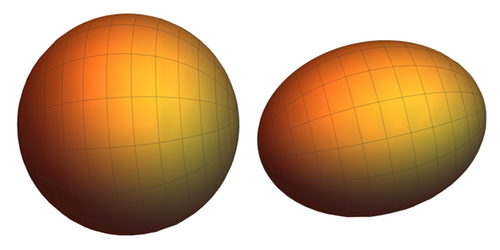Changing the Shape of a Zirconium Nucleus
Atomic nuclei aren’t always spherical. The shape of a nucleus can change when neutrons are added to an element to create a heavier isotope. The distortion also occurs when nucleons are shuffled into different nuclear orbits. Zirconium is a prime example of an element with a shape-shifting nucleus: The ground state of zirconium-96, which contains 40 protons and 56 neutrons, is spherical, while that of zirconium-100, with its extra four neutrons, is shaped more like an American football. Now, a team has found the isotope—zirconium-98—in which the shape of zirconium’s nucleus transitions. The result could enable precise predictions of the energies and lifetimes of exotic nuclei that cannot be produced on Earth.
Waldemar Witt of the Technical University of Darmstadt, Germany, and colleagues fired a beam of zirconium-98 isotopes at a platinum foil to nudge their nuclei into higher energy states. They then measured the spectrum of gamma rays emitted as the isotopes lost energy. Using the data, the team deduced the transition probabilities for two different energy decay paths of the isotopes. These probabilities are known to depend on the number of nucleons that participate in the decay process, which allowed the team to identify each nucleus created and use additional analysis to infer the shapes of the nuclei. Their measurements show that the ground state of zirconium-98 is spherical, while the first excited state is deformed. The energy difference between the spherical and deformed nuclei is the smallest measured to date. Thus the team says that their measurements pinpoint the shape transition.
This research is published in Physical Review C.
–Christopher Crockett
Christopher Crockett is a freelance writer based in Arlington, Virginia.





